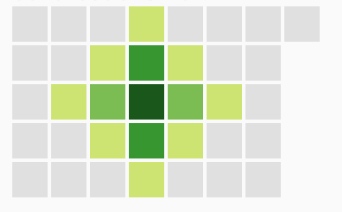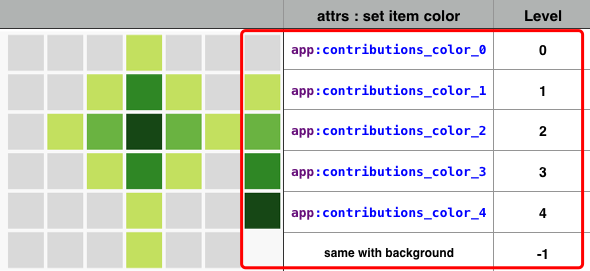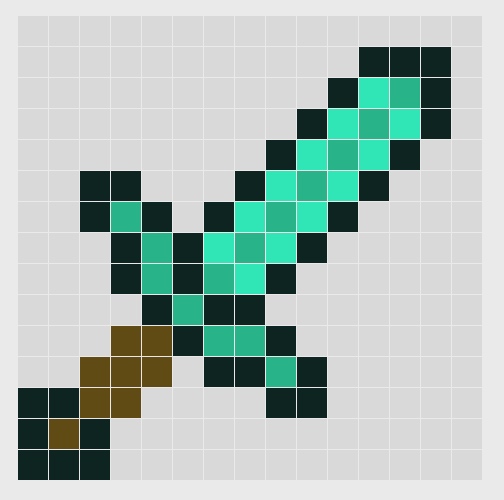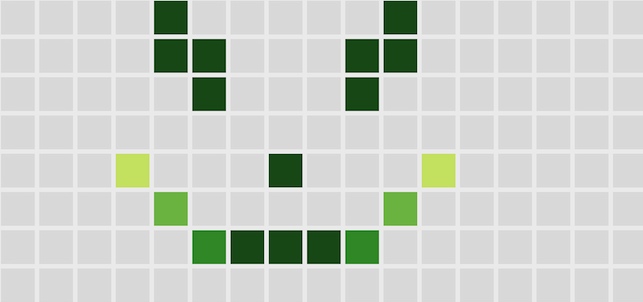TContributionsView can be use for a Contributions View, like in one personal homepage of Github, and more than that.
👻At the beginning, I just want to use it for showing the contributions view like Github, and that's why it named
TContributionsView. But later, I found it seems to be able to do more things than I want …… For example: Github contributions, Pixel painting、Select seats in the cinema、checkerboard……
Import:
compile 'com.barryzhang:tcontributionsview:0.1'If you want to show this :
 

Just writing these codes:
IntArraysContributionsViewAdapter adapter = new IntArraysContributionsViewAdapter();
Integer arrays[][] = {
{0, 0, 0, 1, 0, 0, 0, 0},
{0, 0, 1, 3, 1, 0, 0},
{0, 1, 2, 4, 2, 1, 0},
{0, 0, 1, 3, 1, 0, 0},
{0, 0, 0, 1, 0, 0, 0},
};
adapter.setArrays(arrays);
contributionsView.setAdapter(adapter);😀Isn't very easy?
 
Every rectangle item is mapping to a int value as its level. Now can use level 0 to 4 (like Github),and a extra -1 to express empty status.
Just set different level to different item , you can control them.

Every rectangle item is mapping to a int value as its level. Now can use level 0 to 4 (like Github),and a extra -1 to express empty status.
Just set different level to different item , you can control them.
Set item color、size、if show circle in xml:
<com.barryzhang.tcontributionsview.TContributionsView
android:id="@+id/contributionsView1s"
android:layout_width="wrap_content"
android:layout_height="wrap_content"
app:contributions_use_circle="true"
app:contributions_color_0="#E1DFCE"
app:contributions_color_1="#FFED3B"
app:contributions_color_2="#F4C42E"
app:contributions_color_3="#FB8308"
app:contributions_color_4="#040015"
app:contributions_item_height="10dp"
app:contributions_item_space="1dp"
app:contributions_item_width="10dp"/>Use setAdapter method to bind data to View.
Base usage:
BaseContributionsViewAdapter adapter;
// config adapter
contributionsView.setAdapter(adapter);Several different Adapter were already built in project, and you can also build your custom Adapter very easily by yourself.
Build-in Adapters:
PositionContributionsViewAdapter:Based on (x,y) coordinate.AbstractArraysContributionsViewAdapter:Based on a two-dimensional array, this is intuitive and very very easy to use.IntArraysContributionsViewAdapter:This is extends AbstractArraysContributionsViewAdapter,use Int two-dimensional array.DateContributionsAdapter:Based on date, with this Adapter, you can easily to get a Contributions View like Github.TestContributionAdapter:A random level Adapter —— I use it as a demo :-D
Mentioned earlier the "Quick Start" was a demo for ArraysContributionsViewAdapter, and in fact, it also can be used to do something much more interesting, like this:
IntArraysContributionsViewAdapter adapter = new IntArraysContributionsViewAdapter();
Integer arrays[][] = {
{0, 0, 0, 0, 0, 0, 0, 0, 0, 0, 0, 0, 0, 0, 0,},
{0, 0, 0, 0, 0, 0, 0, 0, 0, 0, 0, 4, 4, 4, 0,},
{0, 0, 0, 0, 0, 0, 0, 0, 0, 0, 4, 2, 3, 4, 0,},
{0, 0, 0, 0, 0, 0, 0, 0, 0, 4, 2, 3, 2, 4, 0,},
{0, 0, 0, 0, 0, 0, 0, 0, 4, 2, 3, 2, 4, 0, 0,},
{0, 0, 4, 4, 0, 0, 0, 4, 2, 3, 2, 4, 0, 0, 0,},
{0, 0, 4, 3, 4, 0, 4, 2, 3, 2, 4, 0, 0, 0, 0,},
{0, 0, 0, 4, 3, 4, 2, 3, 2, 4, 0, 0, 0, 0, 0,},
{0, 0, 0, 4, 3, 4, 3, 2, 4, 0, 0, 0, 0, 0, 0,},
{0, 0, 0, 0, 4, 3, 4, 4, 0, 0, 0, 0, 0, 0, 0,},
{0, 0, 0, 1, 1, 4, 3, 3, 4, 0, 0, 0, 0, 0, 0,},
{0, 0, 1, 1, 1, 0, 4, 4, 3, 4, 0, 0, 0, 0, 0,},
{4, 4, 1, 1, 0, 0, 0, 0, 4, 4, 0, 0, 0, 0, 0,},
{4, 1, 4, 0, 0, 0, 0, 0, 0, 0, 0, 0, 0, 0, 0,},
{4, 4, 4, 0, 0, 0, 0, 0, 0, 0, 0, 0, 0, 0, 0,},
};
adapter.setArrays(arrays);
contributionsView.setAdapter(adapter); 

Achievement get!
『Time to Strike!』 😁
And with AbstractArraysContributionsViewAdapter, you can use other data type T to express Level, just need to overwrite its int mapLevel(T from) method.
Based on (x,y) position, use it with giving to every item a level, default is level 0. Here is a demo:
PositionContributionsViewAdapter adapter =
new PositionContributionsViewAdapter(8, 17);
adapter.put(0, 4, 4);
adapter.put(1, 4, 4);
adapter.put(1, 5, 4);
adapter.put(2, 5, 4);
adapter.put(0, 10, 4);
adapter.put(1, 10, 4);
adapter.put(1, 9, 4);
adapter.put(2, 9, 4);
adapter.put(4, 7, 4);
adapter.put(4, 3, 1);
adapter.put(5, 4, 2);
adapter.put(6, 5, 3);
adapter.put(6, 6, 4);
adapter.put(6, 7, 4);
adapter.put(6, 8, 4);
adapter.put(6, 9, 3);
adapter.put(5, 10, 2);
adapter.put(4, 11, 1);
contributionsView.setAdapter(adapter);Use DateContributionsAdapter, you can easily to get a Contributions View like Github.
Its row value is already be set to 7 (days of a week).
DateContributionsAdapter adapter = new DateContributionsAdapter() ;
adapter.setWeekCount(10);
adapter.setEndDay("2016-11-20");
adapter.put("2016-10-17", 1);
adapter.put("2016-10-18", 2);
adapter.put("2016-10-19", 3);
adapter.put("2016-10-20", 4);
adapter.put("2016-10-21", 3);
adapter.put("2016-10-22", 3);
adapter.put("2016-10-27", 1);
adapter.put("2016-10-28", 1);
adapter.put("2016-10-20", 1);
adapter.put("2016-11-19", 2);
adapter.put("2016-11-18", 4);
contributionsView.setAdapter(adapter);You can custom an Adapter very easily by yourself, just need to extends BaseContributionsViewAdapter, and overwrite some methods.
// get row
public abstract int getRowCount();
// get column
public abstract int getColumnCount();
// get level(-1~4)
public abstract int getLevel(int row, int column);The build-in TestContributionAdapter is a simple demo:
public class TestContributionAdapter extends BaseContributionsViewAdapter {
private int row;
private int column;
public TestContributionAdapter() { this(7,20); }
public TestContributionAdapter(int row, int column) {
super();
this.row = row;
this.column = column;
}
@Override
public int getRowCount() { return this.row; }
@Override
public int getColumnCount() { return this.column; }
@Override
public int getLevel(int row, int column) {
return (int) (Math.random() * 100) % 10;
}
}Copyright 2016 Barry Zhang
Licensed under the Apache License, Version 2.0 (the "License");
you may not use this file except in compliance with the License.
You may obtain a copy of the License at
http://www.apache.org/licenses/LICENSE-2.0
Unless required by applicable law or agreed to in writing, software
distributed under the License is distributed on an "AS IS" BASIS,
WITHOUT WARRANTIES OR CONDITIONS OF ANY KIND, either express or implied.
See the License for the specific language governing permissions and
limitations under the License.


